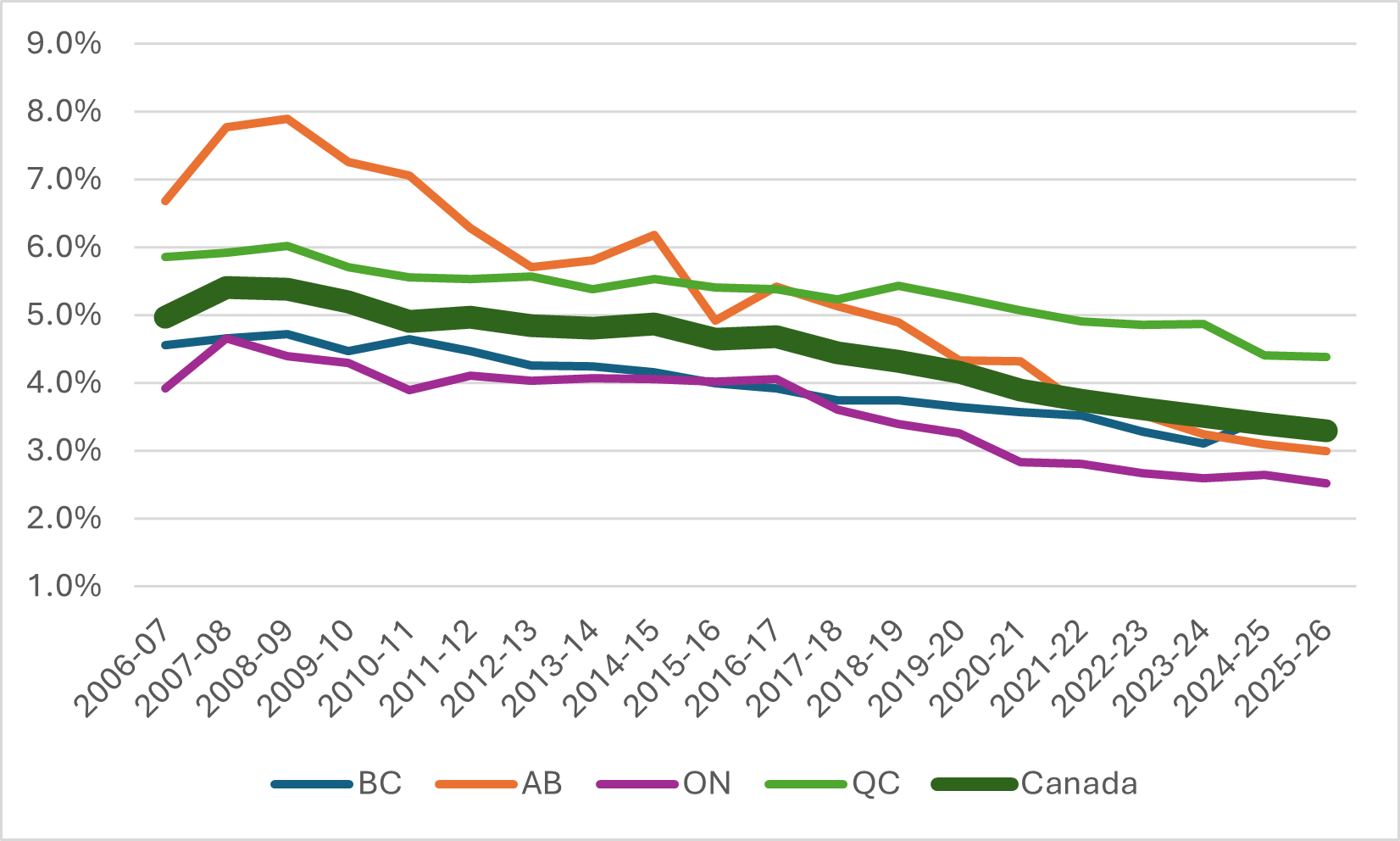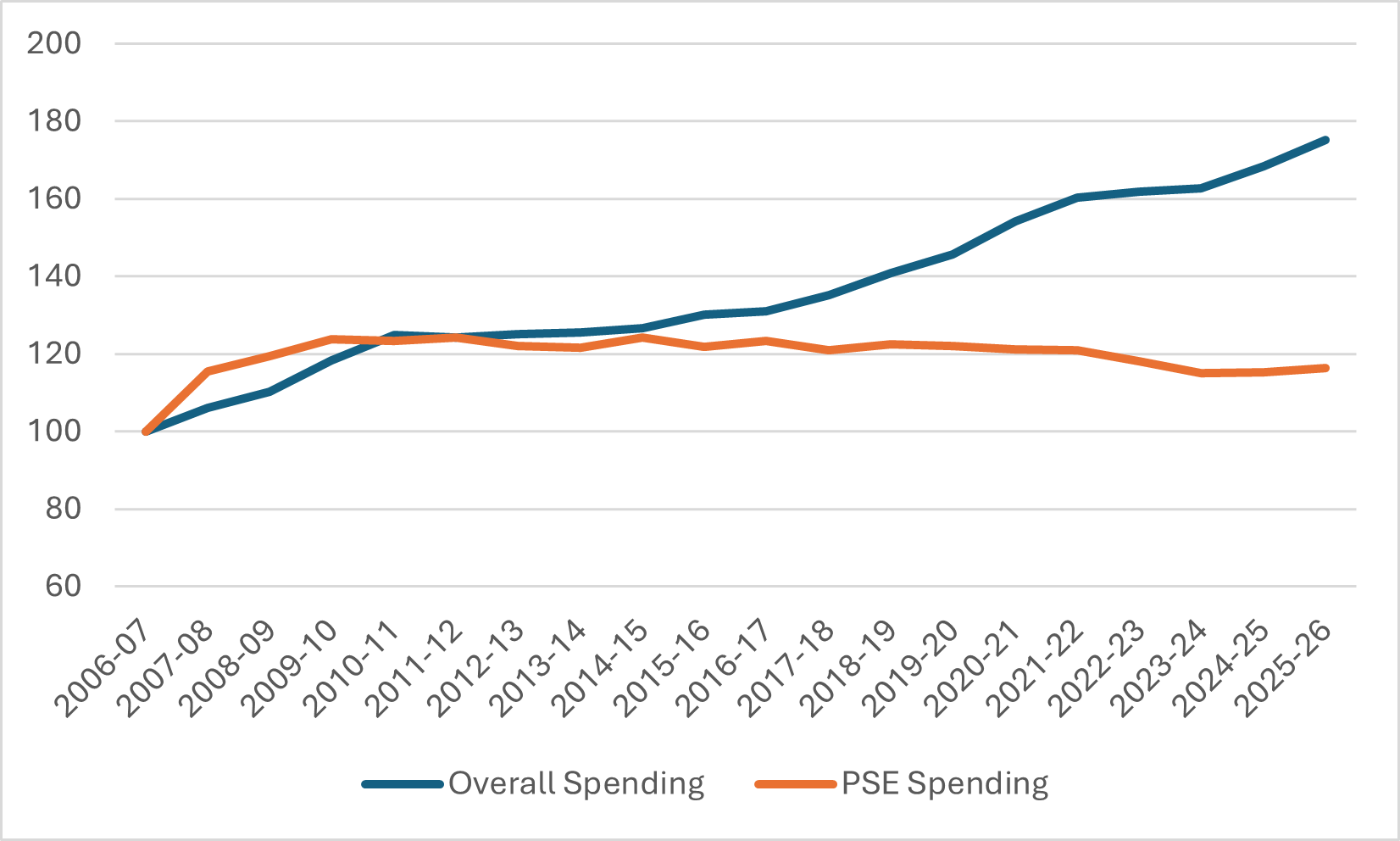Ok everyone, all the provincial budgets are in and so it’s time for our annual look at what another round of irresponsible pan-partisan political leadership has wrought for our sector for the next twelve months.
Figure 1 shows the province-by-province breakdown of this year’s budgets, showing the change in transfers to institutions in real dollars over 1 year and 5 years for each of the ten provinces. In most provinces, collecting this data is pretty easy—you just look at the Main Estimates. In Ontario it is more difficult because due to the Ministry of Finance’s crapulous incompetence, it is the one province in the country where Estimates do not appear on the day of the budget (it takes them several months to put out the detailed data; and while prior to 2018 the Ministry of Colleges and Universities was able to give out actual expenditure data on the day of the Budget, the Government no longer chooses to provide such information because shovel, manure, mushrooms, etc.). So in Ontario what you have to do is collect the previous year’s data, add the announced changes in expenditure, and then make some assumptions about the way funds are phased in (because the communications jackals who have taken over public budgeting in this province insist on phrasing spending as “$750 million over five years” to make numbers as big as possible, rather than explaining how the $750 million will be phased in on an annual basis). Which is all to say, these numbers are all pretty accurate except for Ontario, where there is a bit of a margin of error.
Figure 1: 1-year and 5-year Changes to Budgeted Provincial Transfers to Institutions, Canada, 2025-26 Budget Year

The one province that shows big change for 2025-26 is Prince Edward Island, which dropped a lot of money on UPEI this year in order to start a new medical school. Five other provinces (British Columbia, Alberta, Manitoba, Ontario, and Newfoundland and Labrador saw real increases (that is, increases greater than the rate of inflation) this year of between 1 and 4%. Four other provinces (Saskatchewan, Quebec, New Brunswick, and Nova Scotia) saw real declines of between 1% and 3%. Altogether, that combined nationally for real growth in provincial spending of about 0.9%.
Over a five-year horizon, things are a bit different. The oil provinces—Alberta, Saskatchewan, and Newfoundland and Labrador—have all shown double digit declines in real expenditures (19%, 11%, and 18%, respectively), the “big two” (Quebec and Ontario) are down seven and six per cent respectively, while Nova Scotia and New Brunswick are down eight and two percent respectively. The only provinces that are up are Manitoba, where just before leaving office the Tories reversed a huge portion of their cuts of the previous eight years or so, British Columbia, which build a new med school at Simon Fraser and decided to give hefty wage increases to university and college staff (which did not, in the end, leave universities and college much better off—see Vancouver Island University for evidence), and the afore-mentioned PEI. Nationally, the drop in spending after inflation was 4%, and obviously would have been much higher without that anomalous BC result.
So what does the overall picture look like nationally? Well, take a look at Figure 2. Basically, the picture is one of long-term stagnation.
Figure 2: Total Budgeted Provincial Expenditures on Post-Secondary Education, 2006-07 to 2025-2025, in Billions of Constant 2025 dollars

I suppose I should also update some charts I first made available earlier this year, looking at expenditures on post-secondary education as a percentage of total government expenditures, which I do below in Figure 3. Across the country, these percentages are down a long way over the past fifteen years, particularly in Alberta, which has gone from being by far the biggest spender in 2008 to being below the national average now.
Figure 3: Budgeted Provincial Expenditures on Post-Secondary Education as a Percentage of Total Budgeted Provincial Expenditures, Canada and selected provinces, 2006-07 to 2025-26.

Now, your brain might be whirring a bit trying to would out how Figures 2 and 3 can both be true. Overall spending is down only gently, but PSE expenditures as a percentage are crashing? It’s easy to explain, but not intuitive if you believe all the left-wing CBC nonsense about how governments are in austerity mode. This is nonsense: Canadian provincial governments are absolutely NOT in austerity mode. In most provinces, overall spending is wayyy up. It’s just that they are not choosing to spend any of that on postsecondary education. Since COVID, overall government expenditure is up 20% after inflation; since 2008-09, when post-secondary education peaked as a percentage of total expenditures, it’s up 59% after inflation.
Figure 4: Real Change in Total Provincial Expenditures vs. Provincial Expenditures on Post-Secondary Education 2006-07 to 2025-26 (2006-07 = 100)

Got it? Provinces are still spending. They just aren’t spending on postsecondary education.
Anyways, just to finish things off, figure 5 shows changes in overall provincial spending on student assistance programs. It’s up a bit this year mainly because of Ontario. Unclear why there has been a rise, though I suspect it has something to do with the ongoing crappiness in the youth job market (something I will get back to in a blog next week) and the need for student aid to backfill.
Figure 5: Total Budgeted Provincial Expenditures on Student Financial Assistance, Canada 2006-07 to 2025-26, in Billions of Constant 2025 Dollars

So that’s your 2025-26 budget round up. Not as bad as some previous years but man, our sector is in a bit of a whole and just can’t get out of it. The message, as always, is: no one is coming to save us.

 Tweet this post
Tweet this post

Maybe governments have decided that the Human Capital Century really is over, or nearly so. Which is why we see what additional public spending there is for PSE directed to technology R&D and STEM graduates. Maybe it is time to re-read Willem Vanderberg’s Labyrinth of Technology and George Falliis’ Rethinking Higher Education. Perhaps it is true that, as Fallis’ analysis demonstrates, Ontario has already achieved universal participation, that funding formulas should not reward growth, and that systems need not be designed with broad undifferentiated access as a priority.